

[
] 167
E
nergy
Methodology
With the assistance of EPC and SMD, rainfall data for Afulilo Dam
and surrounding stations were obtained, along with storage, stream-
flow and power generation records from the Ta’elefaga Powerhouse.
Data requirements for calibrating the hydrological model included:
• Climate (rainfall, temperature and evaporation data)
• Inflow to the dam (catchment streamflow)
• Rainfall-runoff relationship for Afulilo catchment
• Dam release downstream from the dam
• Dam release to Ta’elefaga Powerhouse for power generation
• Dam storage characteristics (full storage/dead storage levels, cross-
section of spillway)
• Storage area-volume-elevation relationship for Afulilo Dam
• Estimated seepage rates and losses
• Turbine efficiency (or rating curves)
• Outflow-to-power-generation relationship at different storage
levels (change in turbine efficiency).
Long-term (1900-2010) daily climate data for Afulilo were generated,
based on Apia climate data and using the stochastic weather generator,
WeatherMan.
6
Since daily streamflow data were limited for the Afulilo
catchment, an appropriate rainfall-runoff relationship had to be derived
from the streamflow records of the neighbouring Vaipu catchment using
the IHACRES software package.
7
This relationship was then used to
calculate inflow to Afulilo Dam. Outflow to the Ta’elefaga Powerhouse
was calculated based on daily records of electricity generation fromEPC.
Using the derived inflow and outflow rates, a hydrological water
balance model for Afulilo Dam was developed and calibrated against
historical dam levels as well as power generation data for 1993-2010.
Analysis showed a significant correlation between seasonal storage
volumes and ENSO, with El Niño periods tending to
coincide with lower storage volumes and La Niña periods
tending to coincide with higher ones.
Results
A comparison of observed and modelled storage levels
was made for a validation period of 1 August 1993 to
28 February 2010. While the model will become more
accurate as more hydrological data become available for
EPC, it was considered sufficiently accurate to begin
considering long-term supply and demand scenarios.
Several variables were incorporated into this
ensemble of long-term supply and demand simula-
tions to assess each of their effects on dam storage
and energy generation potential, and to assess dam
performance under different scenarios. These vari-
ables consisted of a matrix of power demand, power
generation capacity, water storage capacity and rain-
fall variability.
The simulations showed that under the current
average power demand, the dam storage level falls
below 10 per cent of usable capacity on an average of
five days per year. If energy demand continues to grow
at the projected 4 per cent per year, then by 2020 the
number of days where usable storage drops below 10
per cent will rise to 70 days per year. The results also
showed a 20 per cent increase in the frequency of low
storage volume under El Niño as compared to La Niña
conditions, further underlining the significant effect of
climate variability on energy security in Samoa.
Capacity improvement options at Afulilo Dam
Source: Australian BoM
















